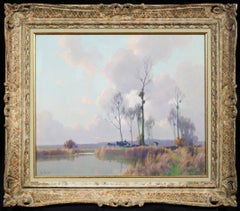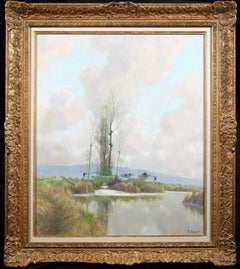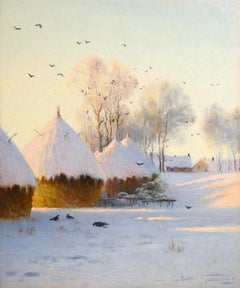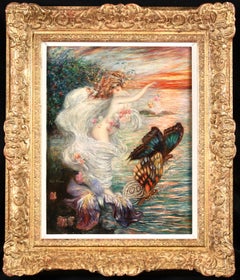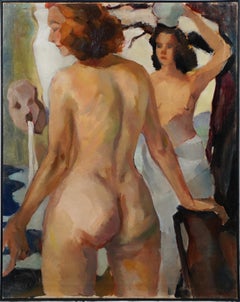Leighton Fine Art Ltd Animal Paintings
to
18
16
1
12
6
5
2
6
5
Overall Height
to
Overall Width
to
10
3
3
11
6
3
3
2
2
1
1
1
1
1
1
1
1
1
1
1
1
1
1
6
12
2
1
1
2
2
1
2
2
2
1
1
18
18
13
13
4
Marecages en Seine et Marne - Impressionist Riverscape Oil by Alexandre Jacob
By Alexandre Louis Jacob
Located in Marlow, Buckinghamshire
Signed oil on canvas landscape circa 1940 by popular French impressionist painter Alexandre Louis Jacob. The piece depicts workers loading wood onto a cart being pulled by a white ho...
Category
1940s Impressionist Landscape Paintings
Materials
Canvas, Oil
Avant Printemps au Marais - Impressionist Riverscape Oil by Alexandre Jacob
By Alexandre Louis Jacob
Located in Marlow, Buckinghamshire
Signed oil on canvas landscape circa 1950 by popular French impressionist painter Alexandre Louis Jacob. The piece depicts horses and their carts being led across small stone bridges...
Category
1950s Impressionist Landscape Paintings
Materials
Oil, Canvas
Matinee d'Hiver a Evergnicourt - Impressionist Landcape Oil by Armand Guery
By Armand Guery
Located in Marlow, Buckinghamshire
Signed and dated impressionist oil on canvas landscape by French painter Armand Guery. The work depicts a rural winter scene with snow covered haystacks to the left and the trees and...
Category
Early 1900s Impressionist Landscape Paintings
Materials
Canvas, Oil
Nymphs with Butterflies - Impressionist Nude in Landscape Oil by Abel Faivre
By Jules-Abel Faivre
Located in Marlow, Buckinghamshire
Signed impressionist figure in landscape oil on canvas circa 1895 by French painter, illustrator and cartoonist Abel Faivre. The work depicts a water nymph with flowing red hair throwing flowers into a river. There are butterflies by her side. The sun set is lighting the sky red.
Signature:
Signed lower left
Dimensions:
Framed: 22"x19"
Unframed: 16"x13"
Provenance:
Private French collection
Born 30 March 1867, in Lyons; died August 1945.
Painter, watercolourist, pastellist, draughtsman, illustrator. Genre scenes, portraits, figures, nudes, interiors, still-lifes (fruit). Humorous cartoons...
Category
1890s Impressionist Nude Paintings
Materials
Canvas, Oil
Gardeuse de Moutons - Impressionist Figure in Landscape Oil by Julien Dupre
By Julien Dupré
Located in Marlow, Buckinghamshire
Signed impressionist oil on canvas figure and animals in landscape by French painter Julien Dupre. The work depicts a shepherdess resting on a log as her sheep graze in the green mea...
Category
1880s Impressionist Animal Paintings
Materials
Canvas, Oil
At the Races - Post Impressionist Horses & Figures Oil by Jacques-Emile Blanche
By Jacques Emile Blanche
Located in Marlow, Buckinghamshire
Signed post impressionist horses and figures in landscape oil on canvas by French painter Jacques-Emile Blanche. The work depicts crowds of people enjoying a day at the races and watching a steeplechase horse race as the horses and their jockey's jump a fence.
Signature:
Signed lower right
Dimensions:
Framed: 28"x36"
Unframed: 21"x29"
Provenance:
Private French collection.
This work has been authenticated by Dr Jane Roberts and a certificate of authenticity will accompany the painting.
Blanche received training from Gervex and Fernand Humbert. His grandfather was Émile Antoine Blanche, the psychiatrist who treated the poet Gérard de Nerval on several occasions. He was awarded a gold medal at the Exposition Universelle in Paris in 1900, and was a Commander of the Légion d'Honneur. He was well known in French and British artistic circles, and married the daughter of John Lemoine, the leader of the Diary of the Proceedings ( Journal des Débats), and author of the Life of Brummel. He exhibited his works in London and Paris.
Blanche had a wide circle of acquaintances, and the list of portraits which he executed is indicative of the diversity of those who used to meet at his home: Henri Bergson; Stéphane Mallarmé; Henry Bernstein (1902); André Gide (1912); Anna de Noailles (1912); Jean Cocteau (1912); Igor Stravinsky (1915); Francis Jammes (1917); Paul Claudel (1919); Jean Giraudoux; Paul Valéry; Marcel Proust; Max Jacob (1921); Maeterlinck (1931); Debussy; Antoine Bourdelle; George Moore; André Maurois; François Mauriac; Maréchal Foch and the Princess de Broglie.
He also wrote novels, which were more or less autobiographical, and essays, such as From David to Degas; Dates; From Gauguin to the Negro Review; Journals of an Artist ( De David à Degas; Dates; De Gauguin à la Revue nègre; Cahiers d'un artiste) in six volumes, and Manet. During meetings at his studio, he used to collect any snippets that would flesh out the essays he wrote, which alternated between being sharp and emotive. He gave them in series to the magazine Comoedia, under the title of Studio Talk. It was said that he aroused tremendous debate, notably with André Lhote, a painter younger than himself, who also doubled as a critic. The latter initially attempted to define the main characteristics of the art of the 'rebellious and charming Jacques Émile Blanche,' but subsequently treated him less generously, referring to a painter 'attached to the notion of 'high-and-mighty' genre painting.' He added that this sort of painting was marvellously illustrated by Manet.
The quality of his flat surfaces, the precious greys and silvery light effects cause Jacques Émile Blanche to be compared more with Manet, whom he admired, than with the Impressionists, with whom he was compared in terms of his early works. Nevertheless, his outdoor backgrounds with traces of sometimes vivid colours have something in common with them.
In the aftermath of World War I, he spent a long time on an enormous composition entitled Tribute to those who Died in the War. It was executed in a style which was totally different to his work as a whole. He offered this work to the church in Offranville near Dieppe. He also donated around 100 of his works to the Musée des Beaux-Arts in Rouen.
He regularly exhibited in Paris, at the Salon of the Société Nationale des Beaux-Arts (also known as the Salon de Mars) from the time it was founded in 1890. At the time of the initial exhibitions held by the Société Nationale des Beaux-Arts, he rapidly gained fame by exhibiting such portraits as Paul Adam and Charles Cottet. He sometimes grouped together several members of the same family in one painting: The Painter Thaulow and His Family in 1895, The Vielé-Griffin Family, and numerous refined portraits of key figures in France and England.
Apart from this Salon, for which he was one of the first driving forces and founder members, he was later to put in a great deal of effort on the occasion of the Salon des Tuileries between 1933 and 1939, even though he was by then in his seventies and already famous.
He exhibited genre scenes, scenes of fashionable places - like Brighton or Dieppe - and racecourse scenes at the Salon des Tuileries in 1933. These included Family of Pedlars in London; Portrait of the Female Novelist Sylvia Thompson; Racecourses in Ireland; Arrival of the Herring in Dieppe; White Masts; Brighton; in 1934: Portrait of James Joyce; Grand National Steeplechase; Spring Races in England (sketch); Dieppe Beach; Outer Harbour of Dieppe in Autumn; in 1935: Rugby; Walter Richard Sickert; Dieppe; Tea Party at the Madeleine; in 1939: Love Thy Neighbour. Many exhibitions have been dedicated to him since his death, including one at the Musée des Beaux-Arts in Rouen in 1997, and one at the Galerie Philippe Heim in Paris in 1999.
Museum and Gallery Holdings:
Brussels: Portrait of the French Painter Charles Cottet
Dieppe: Sleeping Child; Fish Week
Dijon: General Mangin; The Sailing Ship
London (Tate Collection): Francis Poictevin (1887, oil on canvas, portrait); Charles Conder (1904, oil on canvas, portrait); Ludgate Circus: Entrance to the City (November, Midday) (c. 1910, oil/panel); August Morning, Dieppe Beach (c. 1934, oil on canvas); other paintings
Lyons: Portrait of Debussy
Mulhouse: Begonias
Paris (Louvre): The Painter Thaulow and his Family (1895)
Paris (MAM): The Pink Room; The Port at Le Havre; Flowers in a Vase; Still-life; Portrait of the Artist's Mother (June 1895); Portrait of Igor Stravinsky
Paris (Mus. Carnavalet): Portrait of Jean Cocteau...
Category
Mid-20th Century Post-Impressionist Animal Paintings
Materials
Oil, Canvas
Dans le verger - Impressionist Landscape Oil by Margaret Campbell Macpherson
By Margaret Campbell MacPherson
Located in Marlow, Buckinghamshire
Signed oil on canvas animals in landscape by Canadian impressionist painter Margaret Campbell Macpherson. This charming piece depicts a Breton girl in traditional clothing feeding tu...
Category
1890s Impressionist Animal Paintings
Materials
Canvas, Oil
Molyvos, Ile de Lesbos - Expressionist Animal Oil Painting by André Brasilier
By André Brasilier
Located in Marlow, Buckinghamshire
Signed oil on canvas animals in landscape by French expressionist painter Andre Brasilier. The piece depicts goats and birds in front of green trees with a blue sea beyond. This earl...
Category
1960s Expressionist Animal Paintings
Materials
Oil, Canvas
La Vieille Ferme - Academic Landscape Oil by Marie-Francois Firmin-Girard
By Marie-Francois Firmin-Girard
Located in Marlow, Buckinghamshire
Signed landscape oil on canvas circa 1890 by French Academic painter Marie-Francois Firmin-Girard. The work depicts a farmyard filled with animals - cows, horses, chickens and ducks.
Signature:
Signed lower left
Dimensions:
Framed: 29"x35"
Unframed: 20"x26"
Provenance:
Private French collection
As a very young man in 1854, Firmin Girard entered the studios of Charles Gleyre...
Category
Late 19th Century Academic Landscape Paintings
Materials
Canvas, Oil
Horse & Rider - Expressionist Portrait Oil Painting by Gen Paul
By Gen Paul
Located in Marlow, Buckinghamshire
Signed expressionist oil on board portrait circa 1950 by French painter and engraver Gen Paul. This charming work depicts a jockey wearing red jacket and breeches seated on a white horse. This work is likely a painting of the fictional character Don Quixote from the novel by Miguel De Cervantes. Paul painted this subject on numerous occasions.
Signature:
Signed lower right
Dimensiosn:
Framed: 26.5"x21.5"
Unframed: 16"x11"
Provenance:
Private French collection of the work of Gen Paul
Gen-Paul was born in the Rue Lepic, at the heart of Montmartre. His mother was an embroiderer, and his father was a café musician. Gen-Paul began painting from a young age. An apprentice interior decorative artist, he looked about him in the wealthy apartments where his work took him and observed the pieces collected by art lovers, and he learned anatomy by getting to know surgeons and going with them into operating theatres. He also attended the École des Beaux-Arts. He painted on discarded cigar boxes using coloured supplements from L'Illustration as models. This was in 1913. At the outbreak of World War I he volunteered for service and was wounded; a year later a second wound led to the amputation of his right leg. Back in Paris in 1916, he began to paint. His first oil painting, the Moulin de la Galette seen from his window, dates from 1916. His early works are not easy to identify, as he painted many views of Paris to satisfy customers who wanted a painting 'in the style of so-and-so'. In 1918 he first signed a canvas Gen-Paul. In 1920 he showed work at the Salon d'Automne, remaining faithful to this institution and to the Salon des Indépendants. His first solo show took place in the Galerie Bing in 1926. He illustrated several of Céline's books, including Journey to the End of Night, Death on Tick ( Voyage au bout de la nuit, Mort à crédit) in 1942. He also produced engravings, some of which were published as a collection entitled Views of Montmartre ( Les vues de Montmartre). When World War II ended he travelled frequently to the USA and New York. In 1952 the Galerie Drouant-David in Paris put on a retrospective dedicated to him. Gen-Paul did not exhibit much, had no dealer, and travelled frequently in France and Spain. Posthumous collective exhibitions include: Galerie Roussard...
Category
1950s Expressionist Abstract Paintings
Materials
Board, Oil
Radiant Autumn -Wakken - Post Impressionist Oil, Cows in Landscape - Modest Huys
Located in Marlow, Buckinghamshire
Signed and dated divisionist landscape oil on canvas by Belgian post impressionist painter Modest Huys. This stunning piece is titled "Radiant Autumn - Wak...
Category
Early 20th Century Post-Impressionist Landscape Paintings
Materials
Canvas, Oil
Le Cadre Noir de Saumur - Expressionist Oil, Figures on Horse by André Brasilier
By André Brasilier
Located in Marlow, Buckinghamshire
Signed oil on canvas circa 1965 by French expressionist painter Andre Brasilier. The work depicts four military men in French naval uniform on black horses. A wonderful piece in the artist's distinctive style.
Signature:
Signed: Signed lower left
Dimensions:
Framed size: 28"x32"
Unframed: 20"x24"
Provenance:
Private French collection
André Brasilier was the son of the painter Jacques Brasilier. After studying in Saumur and St-Germain-en-Laye, he joined Brianchon's studio in 1949 at the École des Beaux-Arts in Paris. He was awarded the Prix Florence-Blumenthal in 1952 and the Grand Prix de Rome in 1953. He lived at the Villa de' Medicis from 1954 to 1957. He also received the Prix Charles-Morellet at the Salon de la Jeune Peinture in 1961 and the Prix de Villeneuve-sur-Lot in 1962.
Brasilier's paintings are populated by beautiful, elegant women, respectable nudes and high-class gentlemen and are set in pleasant Val-de-Loire backgrounds, resplendent with landscapes and charming towns. Revealing the distant inspiration of Gauguin and the well-assimilated influence of certain other artists, Brasilier depicts a peaceful, comfortable world, free from care, in a very simple, stylish manner, with delicate harmonies bathed in accommodating sunlight.
Brasilier took part in group exhibitions from 1956, including many in Paris: at the Salon de la Jeune Peinture; regularly at the Salon d'Automne; at the École de Paris exhibition at the Galerie Charpentier (1954-1957); at the Paris Biennale (1961 and 1963); and at the Salon Comparaisons (1961-1964). Mainly, however, he showed his work in solo exhibitions, including: at the Galerie Drouet in Paris (1959); at the Galerie Weil in Paris (1960 and 1964); at the David B. Finlay Gallery in New York (1962, 1971 and 1974); at the Atelier Mourlot in Paris (1964); at the Galerie Guiot in Paris (1967); at the Galerie de Paris (1969, 1972 and 1976); at the Yoshii Gallery in Tokyo (1969, 1974 and 1977); at the Galerie Matignon in Paris (1979); a first retrospective at the Château de Chenonceau in Paris (1980); at the Nichido Gallery in Tokyo (1983); a retrospective at the Musée Picasso in Antibes...
Category
Mid-20th Century Expressionist Animal Paintings
Materials
Canvas, Oil
Au Cirque - Post Impressionist Oil, Figures & Horse at Circus by Marcel Cosson
By Jean-Louis-Marcel Cosson
Located in Marlow, Buckinghamshire
Signed oil on board circa 1930 by French post impressionist painter Jean-Louis-Marcel Cosson. The piece gives a behind the scenes look at a French circus. The ringmaster, dressed in ...
Category
1930s Post-Impressionist Figurative Paintings
Materials
Canvas, Oil
The Artist's Garden - Impressionist Oil, Cat in Garden Landscape by Henri Duhem
By Henri Duhem
Located in Marlow, Buckinghamshire
Signed and dated impressionist oil on panel by French painter Henri Duhem. The work depicts a the artist's garden. A statue stands beside a water fountain while a cat rests in the sh...
Category
Early 1900s Impressionist Landscape Paintings
Materials
Oil, Panel
L'embarquement de boeufs - Impressionist Oil, Cattle by Jean Francois Raffaelli
By Jean-Francois Raffaelli
Located in Marlow, Buckinghamshire
Wonderful signed oil on panel cattle and figures in landscape by French impressionist painter Jean-Francois Raffaelli. The work depicts oxen being loaded onto ships in Honfleur, France en route to England.
Signature:
Signed lower right
Dimensions:
Framed: 18"x16"
Unframed: 9"x8"
Provenance:
Exhibition Jean Francois Raffaélli held at Galerie Simonson, 19 Rue Caumartin Paris - October 1929 (number 44)
Jean-François Raffaëlli's father was a failed Italian businessman and Raffaëlli himself was, among other things, a church chorister, actor and theatre singer. He then studied under Gérôme at the École des Beaux-Arts in Paris. He travelled to Italy, Spain and Algeria and on his return to France settled in Asnières.
In 1876, on a trip to Brittany, he first saw the potential of realist subject matter, if treated seriously. He became involved in meetings of artists at the Café Guerbois, where the Impressionist painters used to gather. As a result, Degas, contrary to the advice of the group, introduced Raffaëlli to the Impressionist exhibitions - according to one uncertain source as early as the very first exhibition, at the home of Nadar, and certainly to those of 1880 and 1881.
In 1904, Raffaëlli founded the Society for Original Colour Engraving. He first exhibited at the Salon de Paris in 1870 and continued to exhibit there until he joined the Salon des Artistes Français in 1881, where he earned a commendation in 1885, was made Chevalier of the Légion d'Honneur in 1889 and in the same year was awarded a gold medal at the Exposition Universelle. In 1906 he was made Officier of the Légion d'Honneur. He was also a member of the Société Nationale des Beaux-Arts. In 1884, a private exhibition of his work cemented his reputation.
He contributed to several newspapers such as The Black Cat (Le Chat Noir) in 1885 and The French Mail (Le Courrier Français) in 1886 and 1887. He published a collection entitled Parisian Characters, which captured his favourite themes of the street, the neighbourhood and local people going about their lives. In 1880 he participated, with Forain, on the illustration of Joris Karl Huysmans' Parisian Sketches (Croquis Parisiens). He also illustrated Huysman's Works. As well as working as an illustrator, he also made etchings and coloured dry-points.
His early attempts at painting were genre scenes, but once he was settled in Asnières he started to paint picturesque views of Parisian suburbs. From 1879 onwards, his subject matter drew on the lives of local people. These popular themes, which he treated with humanity and a social conscience, brought him to the attention of the social realist writers of the time such as Émile Zola. In addition to his realist style, Raffaëlli's dark palette, which ran contrary to the Impressionist aesthethic, helped to explain the opposition of those painters to his participation in their exhibitions. More concerned with drawing than colour, he used black and white for most of his paintings. Towards the end of his life, he lightened his palette, but without adopting any other principles of the Impressionist technique.
After painting several portraits, including Edmond de Goncourt and Georges Clémenceau, he returned to genre painting, particularly scenes of bourgeois life. Later in his career, he painted mainly Breton-inspired sailors and views of Venice. His views of the Paris slums and the fortifications, sites which have almost completely disappeared, went some way towards establishing a genre in themselves and perpetuated the memory of the area: The Slums, Rag-and-Bone Man, Vagabond, Sandpit, In St-Denis, Area of Fortifications. His realistic and witty portrayal of typical Parisian townscapes accounts for his enduring appeal.
Born in Paris, he was of Tuscan descent through his paternal grandparents. He showed an interest in music and theatre before becoming a painter in 1870. One of his landscape paintings was accepted for exhibition at the Salon in that same year. In October 1871 he began three months of study under Jean-Léon Gérôme at the École des Beaux-Arts in Paris; he had no other formal training.
Raffaëlli produced primarily costume pictures until 1876, when he began to depict the people of his time—particularly peasants, workers, and ragpickers seen in the suburbs of Paris—in a realistic style. His new work was championed by influential critics such as J.-K. Huysmans, as well as by Edgar Degas.
The ragpicker became for Raffaëlli a symbol of the alienation of the individual in modern society. Art historian Barbara S. Fields has written of Raffaëlli's interest in the positivist philosophy of Hippolyte-Adolphe Taine, which led him to articulate a theory of realism that he christened caractérisme. He hoped to set himself apart from those unthinking, so-called realist artists whose art provided the viewer with only a literal depiction of nature. His careful observation of man in his milieu paralleled the anti-aesthetic, anti-romantic approach of the literary Naturalists, such as Zola and Huysmans.
Degas invited Raffaëlli to participate in the Impressionist exhibitions of 1880 and 1881, an action that bitterly divided the group; not only was Raffaëlli not an Impressionist, but he threatened to dominate the 1880 exhibition with his outsized display of 37 works. Monet, resentful of Degas's insistence on expanding the Impressionist exhibitions by including several realists, chose not to exhibit, complaining, "The little chapel has become a commonplace school which opens its doors to the first dauber to come along."An example of Raffaëlli's work from this period is Les buveurs d'absinthe (1881, in the California Palace of Legion of Honor Art Museum in San Francisco). Originally titled Les déclassés, the painting was widely praised at the 1881 exhibit.
After winning the Légion d'honneur in 1889, Raffaëlli shifted his attention from the suburbs of Paris to city itself, and the street scenes that resulted were well received by the public and the critics. He made a number of sculptures, but these are known today only through photographs.[2] His work was also part of the painting event in the art competition at the 1912 Summer Olympics. In the later years of his life, he concentrated on color printmaking. Raffaëlli died in Paris on February 11, 1924
Museum and Gallery Holdings:
Béziers: Peasants Going to Town
Bordeaux: Bohemians at a Café
Boston: Notre-Dame; Return from the Market
Brussels: Chevet of Notre-Dame; pastel
Bucharest (Muz. National de Arta al României): Market at Antibes; Pied-à-terre
Copenhagen: Fishermen on the Beach
Douai: Return from the Market; Blacksmiths
Liège: Absinthe Drinker...
Category
1880s Impressionist Animal Paintings
Materials
Oil, Panel
Enfants et les oies - Realist Oil, Figures & Geese in Landscape by Paul Druard
Located in Marlow, Buckinghamshire
A beautiful and charming oil on panel circa 1890 by French realist painter Paul Druard. The work is a depiction of farm life. A mother is seated on the grass with a daughter seated t...
Category
1890s Realist Figurative Paintings
Materials
Oil, Panel
The Great War - Impressionist Oil, Figure & Horse in Landscape by Andre Devambez
By André Devambez
Located in Marlow, Buckinghamshire
Wonderful oil on panel circa 1920 by French impressionist painter Andre Devambez. The work depicts a soldier leading his horse along a dirt track during...
Category
1910s Impressionist Animal Paintings
Materials
Panel, Oil
Montriant - Les Glycines - Impressionist Oil, Garden Landscape by Henri Duhem
By Henri Duhem
Located in Marlow, Buckinghamshire
A wonderful oil on artist's board by French Impressionist painter Henri Duhem depicting beautiful purple wisteria on the side of a building as a cat walks through the courtyard and t...
Category
1940s Impressionist Landscape Paintings
Materials
Canvas, Oil, Board
Related Items
Antique American Impressionist Nude by Stream Exhibited Framed Oil Painting
Located in Buffalo, NY
Antique American impressionist landscape with a nude bather by Henrik Hillblom (1863 - 1948).
Category
1920s Impressionist Nude Paintings
Materials
Canvas, Oil
Vintage Paris School Nude Female Bathers Double Sided Impressionist Oil Painting
Located in Buffalo, NY
Antique impressionist nude woman portrait oil painting. Oil on canvas. Framed.
Category
1950s Impressionist Nude Paintings
Materials
Canvas, Oil
H 29 in W 37 in D 2 in
Ray Simonini, "Violet" 8x10 Impressionist Farm Animal Cow Oil Painting on Canvas
By Ray Simonini
Located in Saratoga Springs, NY
This painting by artist Ray Simonini titled "Violet" is a 8x10 farm animal oil painting on canvas featuring a portrait of a brown and white co...
Category
2010s Impressionist Animal Paintings
Materials
Canvas, Oil
plowing with oxen oil on board painting Spain
By Juan Soler
Located in Barcelona, Barcelona
Oil measures 30x30 cm.
Frame measures 52x52 cm.
He was born in 1951. Under the direction of the teacher Pedro Bermejo, he began his artistic career, quickly standing out and observing in his works an unusual mastery of drawing.
A highly mature painter who has known how to stop time in all his works. His themes are preferably costumbrist, although in his work it is usual to see 18th century themes, with horse carriages, hats, umbrellas and still lifes.
Observing his work reminds us, due to the theme, of Maestro Palmero...
Category
21st Century and Contemporary Post-Impressionist Animal Paintings
Materials
Oil, Board
Silence
Located in Bogotá, Bogotá
Figurative painting of a fantastic animal that is part of our lives. A magical moment in life: a whale. It is a horizontal painting that combines the oil on canvas technique with a g...
Category
2010s Contemporary Animal Paintings
Materials
Cotton Canvas, Oil
Cowboy Driving Cattle, Realist Figurative Landscape
Located in Soquel, CA
Dynamic Western figurative landscape scene of a cowboy and cattle, depicted with realist detail as they splash through a river, by unknown artist Jan Watson (American, 20th Century)....
Category
1980s American Impressionist Animal Paintings
Materials
Oil, Canvas
H 32 in W 44 in D 3 in
The Visit, Chilean Artist, Emerging, Oil Painting , Framed , 14x10, Bird
Located in Houston, TX
The Visit is painted plein aire in the Chilean countryside. It is oil on canvas and has a Italian handmade frame. The frame adds about 3 inches to the size. The austral blackbird (Curaeus curaeus) is a species of bird in the family Icteridae. It is found in Argentina and Chile. Its natural habitats are temperate forests, subtropical or tropical high-altitude shrubland, and heavily degraded former forest.
Viviana Ovando Cid
Visual Artist and Painter.
She studied Visual Arts at the University of Chile and specialized as a Painter at the Martín Soria Academy of Fine Arts. Awarded by the Chilean-Japanese Cultural Institute and the National Society of Fine Arts. Viviana has participated constantly in group and individual exhibitions nationwide, Thanks to her constant concern she handles different painting techniques, from those coined by the Classic Academy to digital techniques, participating in 2D and 3D animation projects, exploring new representation techniques.
Who are your biggest influences? Are you inspired by the work of your colleagues or someone else in particular?
Antonio López, Goya, Rembrandt, Velásquez, Sorolla, Caravaggio, Franz Marc, Muñoz Vera, Sergio Castillo...
Category
2010s Impressionist Landscape Paintings
Materials
Canvas, Oil
H 14 in W 10 in D 1.5 in
San Fermin Pamplona Spain oil on canvas painting
By Juan Soler
Located in Barcelona, Barcelona
Juan Soler (1951) - San Fermin - Oil on canvas
Canvas measures 80x80 cm.
Frameless.
He was born in 1951. Under the direction of the master Pedro Bermejo, he began his artistic career, quickly highlighting and observing in his works an unusual mastery of drawing.
A very mature painter who has known how to stop time in all his works. His themes are preferably costumbristas although in his work the usual thing is to see eight century themes, with horse carriages, hats, umbrellas and still lifes.
Observing his work reminds us, by the subject, of Maestro Palmero...
Category
1990s Impressionist Animal Paintings
Materials
Canvas, Oil
Vintage Signed Southern Pine Forest Wild Horse Sand Trail Framed Oil Painting
Located in Buffalo, NY
Oil on board by Cynthia Norton Eckstrom (1925 - 2015) . Framed. Image size, 18H x 14L. Signed.
Category
1950s Impressionist Landscape Paintings
Materials
Oil, Canvas
Large Antique American Impressionist Winter Horse Landscape Oil Painting
Located in Buffalo, NY
Antique American impressionist winter landscape oil painting. Oil on canvas. No signature found. Framed. Image size, 30L x 24H.
Category
1920s Impressionist Landscape Paintings
Materials
Canvas, Oil
H 28 in W 34 in D 2 in
Franklin White, British Australian Impressionist scene of a cat in a courtyard
By Franklin White
Located in Harkstead, GB
A wonderful image painted in an attractive palette.
Franklin White (1892-1975)
A cat resting in a sunny courtyard
Signed and indistinctly dated (19)41?
Oil on canvas laid on board
...
Category
Mid-20th Century Impressionist Landscape Paintings
Materials
Board, Canvas, Oil
Free Shipping
H 14 in W 10 in D 1.5 in
Love Scorn, classical gestural abstract male nude figure, dog, blues, earth tone
By Tom Bennett
Located in Brooklyn, NY
Homage to baroque allegory, symbolic figurative realism.
About Tom Bennett:
With quick brushstrokes, Tom Bennett creates representational images of human figures and animals, emphas...
Category
2010s American Impressionist Figurative Paintings
Materials
Canvas, Oil
